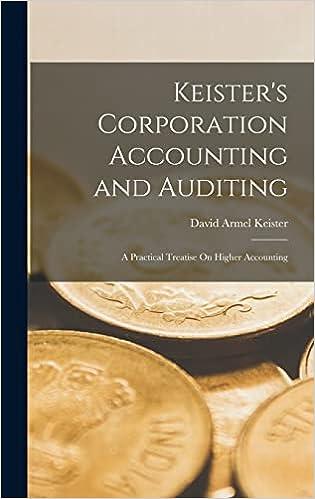Question
1. Dideda Corporation uses an activity-based costing system with three activity cost pools. The company has provided the following data concerning its costs and its
1. Dideda Corporation uses an activity-based costing system with three activity cost pools. The company has provided the following data concerning its costs and its activity based costing system:
| Costs: | |
| Manufacturing overhead | $360,000 |
| Selling and administrative expenses | 240,000 |
| Total | $ 600,000 |
Distribution of resource consumption:
| Activity Cost Pools |
| Order Size | Customer Support | Other | Total | |
| Manufacturing overhead | 25% | 65% | 10% | 100% |
| Selling and administrative expenses | 60^ | 20% | 20% | 100% |
The "Other" activity cost pool consists of the costs of idle capacity and organization-sustaining costs. You have been asked to complete the first-stage allocation of costs to the activity cost pools. How much cost, in total, would be allocated in the first-stage allocation to the Order Size activity cost pool?
2. Ormond Corporation uses activity-based costing to assign overhead costs to products. Overhead costs have already been allocated to the company's three activity cost pools as follows: Machining, $6,800; Order Filling, $10,700; and Other, $4,500. Machining costs are assigned to products using machine-hours (MHs) and Order Filling costs are assigned to products using the number of orders. The costs in the Other activity cost pool are not assigned to products. Activity data appear below:
| Activity: | MHs (Processing) | Batches (Supervising) |
| Product B6 | 1,300 | 400 |
| Product R1 | 18,700 | 600 |
What is the overhead cost assigned to Product B6 under activity-based costing?
| 3. Ibarra Company, which has only one product, has provided the following data concerning its most recent month of operations:
What is the unit product cost for the month under variable costing? |
4. Thoen Nuptial Bakery makes very elaborate wedding cakes to order. The company has an activity-based costing system with three activity cost pools. The activity rate for the Size-Related activity cost pool is $0.96 per guest. (The greater the number of guests, the larger the cake.) The activity rate for the Complexity-Related cost pool is $54.24 per tier. (Cakes with more tiers are more complex.) Finally, the activity rate for the Order-Related activity cost pool is $56.44 per order. (Each wedding involves one order for a cake.) The activity rates include the costs of raw ingredients such as flour, sugar, eggs, and shortening. The activity rates do not include the costs of purchased decorations such as miniature statues and wedding bells, which are accounted for separately. Data concerning two recent orders appear below:
| Nie Wedding | Strobl Wedding | |
| Number of reception guests | 67 | 129 |
| Number of tiers on the cake | 3 | 5 |
| Cost of purchased decorations for cake | $ 23.50 | $ 31.31 |
Assuming that the company charges $584.18 for the Strobl wedding cake, what would be the overall margin on the order?
5. Roshannon Corporation uses activity-based costing to compute product margins. In the first stage, the activity-based costing system allocates two overhead accounts-equipment expense and indirect labor-to three activity cost pools-Processing, Supervising, and Other-based on resource consumption. Data to perform these allocations appear below:
| Overhead costs: | |
| Equipment expense | $52,000 |
| Indirect labor | $ 8,000 |
Distribution of Resource Consumption across Activity Cost Pools:
| Activity Cost Pools |
| Processing | Supervising | Other | |
| Equipment expense | 0.20 | 0.30 | 0.50 |
| Indirect labor | 0.40 | 0.40 | 0.20 |
In the second stage, Processing costs are assigned to products using machine-hours (MHs) and Supervising costs are assigned to products using the number of batches. The costs in the Other activity cost pool are not assigned to products. Activity data for the company's two products follow:
| MHs (Processing) | Batches (Supervising) | |
| Product P3 | 8,700 | 600 |
| Product G0 | 11,300 | 1,400 |
| Total | 20,000 | 2,000 |
Finally, sales and direct cost data are combined with Processing and Supervising costs to determine product margins.
| Sales and Direct Cost Data: | Product P3 | Product G0 |
| Sales (total) | $140,100 | $121,500 |
| Direct materials (total) | $ 47,500 | $ 56,400 |
| Direct labor (total) | $ 78,200 | $ 37,700 |
What is the product margin for Product P3 under activity-based costing?
6. The Bronco Birdfeed Company reported the following information:
| Sales (400 cases) | $100,000 |
| Variable expenses | 60,000 |
| Contribution margin | 40,000 |
| Fixed expenses | 35,000 |
| Net operating income | $5,000 |
How much will the sale of one additional case add to Bronco's net operating income?
Step by Step Solution
There are 3 Steps involved in it
Step: 1

Get Instant Access to Expert-Tailored Solutions
See step-by-step solutions with expert insights and AI powered tools for academic success
Step: 2

Step: 3

Ace Your Homework with AI
Get the answers you need in no time with our AI-driven, step-by-step assistance
Get Started


